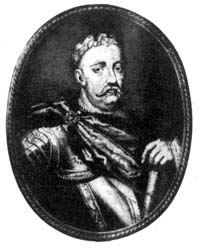Much to our regret, even unbiased historical studies occasionally contain historical untruths. In some cases, the latter lie on the surface, are easy to spot and, hence, not dangerous. For example, some of our chronicles say that the Poles burned Severyn Nalyvaiko, the leader of a Cossack uprising, alive in a bull-shaped brass tank, although reliable sources (I. Belsky) say that he was quartered. Yet, sometimes mistakes are not so innocent: they sneak into a historical work without the author’s knowledge and compel the reader to form a totally wrong idea of a certain fact or historical figure. One such mistake concerns Hetman Stepan Kunytsky.
We know little about Stepan Kunytsky. The descendant of an old noble clan that bore the Drago-Sas coat-of-arms, he once served Hetman Petro Doroshenko, who ruled Right Bank Ukraine in 1665-1676. Kunytsky enjoyed the special confidence of the hetman. This can be proved, e.g., by the fact that when Doroshenko was giving his daughter in marriage to the nephew of Left Bank Hetman Demyan Mnohohrishny, Kunytsky acted as matchmaker.
Doroshenko wanted to establish a Ukrainian state independent of both Poland and Russia. Fighting against Petro Doroshenko, the Polish government was out to destroy the institution of hetman and the regiments, the very backbone of the Ukrainian Cossack state. For this reason, when Ostap Hohol (the direct ancestor of Mykola Hohol/Nikolai Gogol), appointed by the Poles as acting hetman, died in 1679, the Right Bank Cossacks had no hetman for almost three years.
However, faced with the danger of Turkish expansion, Polish King Jan III Sobieski had to turn to the Right Bank Cossacks in 1682 for help in his war against the “infidels.” In return, the king promised to restore all their old freedoms and privileges, promote the equality of Orthodoxy and Catholicism, etc. Although opposed by Left Bank Ukraine’s hetman, the Right Bank Cossacks decided to accept the Polish king’s offer. Cossack regiments took the most active part, together with the armies of other European states, in the siege of Vienna in 1683. Jan III Sobieski also successfully used the Cossacks’ military potential in the victorious “post- Vienna expedition,” in the Battles of Parkany and Esztergom in Slovakia and Hungary, and the subsequent liberation of these lands from the Ottoman yoke.
In the summer of 1683, in keeping with his promise, Jan III Sobieski officially approved the election of viyskovy tovarysh (lieutenant) Stepan Kunytsky as Hetman of Right Bank Ukraine. At the end of 1683 the king sent Kunytsky the hetman’s insignia — the mace and a seal with the emblem of medieval Ukraine (picturing a Cossack infantryman with a musket) — which were later handed down to his successors.
After settling in Nemyriv, Podillia, Kunytsky set about reconstructing Right Bank Ukraine, which was devastated from the military campaigns that had been waged during the hetmanates of Doroshenko and Yuriy Khmelnytsky. He had the old Cossack towns of Korsun, Bohuslav, and Moshny rebuilt. In 1683, when Kunytsky was still in office, the government compiled a register of the Right Bank Zaporozhian Army. That same year the Cossacks began to be paid wages for their service: two large installments were paid from the Polish Kingdom’s treasury and one from the Pope (with the Polish government’s mediation). In the winter of 1683-1684 Jan III Sobieski ordered Kunytsky to march on Moldavia at the head of a 5,000-strong Cossack force to topple the pro-Turkish hospodar Gheorghe Duca and thwart an imminent Turkish expedition to Hungary. After placing the Polish henchman Stefan Petriceicu on the Moldavian throne and thus having accomplished his mission, Kunytsky led the significantly reduced Cossack force home. On their way they passed the Tatar-owned territory of Budzhak and became embroiled in a series of dramatic events inaccurately described by Ukrainian chroniclers. According to a widespread version, when Kunytsky encountered the much stronger Budzhak Tatar force, he fled from the battlefield, leaving the Cossacks to fend for themselves. He was then allegedly killed in Mohyliv-Podilsky by his own Cossacks, who had managed to break out of encirclement.
Here is the account of these events in A History of the Ruthenians: “In 1683 the Polish king confirmed in the office of hetman of the Trans-Dnipro regiments Yakym Kunytsky elected by the Cossacks in place of the previous Hetman Yevstafiy Hohol killed in the Battle of Vienna. But when the king ordered this hetman and his regiments in 1684 to march to Bessarabia in search of the Bilhorod Tatars, who were contemplating a war against Hungary, he saw that the Tatars were in a far greater number than his own force and he deserted his regiments in a cowardly manner, leaving them to their own devices. The Cossacks then proclaimed Dmytro Mohyla, the Colonel of Bratslav, as their commander-in-chief, who regrouped their forces in a phalanx and successfully broke through the Tatar ranks. The Cossacks safely retreated to their borders in a rearguard action, then they found the fugitive Kunytsky and unanimously resolved to put him to death with the blunt ends of their spears” (A History of the Ruthenians, a reprint of the 1846 edition, Kyiv, Dzvin publishers, 1991, p. 180).
Similar descriptions of Kunytsky’s death can also be found in the chronicles of Samovydets, Hryhoriy Hrabianka, and Samiylo Velychko. It is not known, however, what sources these authors used. In general, Kunytsky is one of the least mentioned Cossack hetmans. Curiously enough, we find his name in the written sources of our neighbors, the Moldavians. In 1844, two years before Osyp Bodiansky published A History of the Ruthenians, issue no. 32 of the newspaper Odesskiy vestnik, carried a short story entitled “Hetman Kunytsky. A Moldavian Legend from the Chronicle of Vasile din Baia Mare” by the Moldavian writer Boleslav Hijdeu (Hasdeu). This story says that Kunytsky died in a totally different manner to the one described in the Cossack chroniclers’ version.
Hijdeu writes: “In 1684 the Cossack Hetman Kunytsky invaded Moldavia to liberate it from Turkish captivity and place Stefan Petriceicu on the throne. Betrayed by the Moldavians and pursued by a mighty army of the Tatar khan, he ran into the Budzhak steppe, intending to cross the Dnipro and quickly reach Poland. There were only seven hundred Cossacks left out of the five thousand that Kunytsky had brought. This fragment of the glorious Cossack force billeted on the river Yalpukha’s bank to celebrate Easter Day.” Next morning, the Cossacks had scarcely opened their eyes when they saw a black cloud approaching them from the steppe. This was the 10,000-strong Tatar horde led by the khan’s son. What about Kunytsky? “Hey, jolly good fellows!” Kunytsky said to his warriors, “We are in trouble! Unwelcome guests should be seen off with fire and sword. Let us not put the Cossack blood to shame, let us not disgrace our knightly glory! It is better to lie moldering in the damp soil than to be taken prisoner and serve the infidels as if we were in Egyptian slavery!”
It is clear that Hijdeu’s story is not an historical account but a piece of fiction based on a concrete historical fact. There follows the splendid legend that the khan’s son agreed to let the Cossacks go in peace on condition that a falcon that he will release will have as many wounds as Kunytsky’s Cossacks. The Cossacks accepted the offer, but when the smoke of gunfire had vanished, the Tatars saw that seven hundred Cossack bullets had pierced the heart of their khan, not the white falcon. At the same instant, ten thousand Tatar sabers came crashing down upon the Cossacks’ heads. “Thus the glorious Cossack Hetman Kunytsky and his gallant knights died in Budzhak,” concludes Hijdeu. “Eternal memory to the hero who tried to free Moldavia of the Turkish yoke!”
How did this legend come about and who was the author of the account? It is known that Vasile din Baia Mare, “a relative of the Moldavian hospodar Stefan Petriceicu,” to whom Hijdeu ascribed the role of chronicler, left behind no chronicles at all, but Boleslav Hijdeu himself was a direct descendant of the Moldavian hospodar. His great-great-grandfather Stefan Hijdeu was married to Stefan Petriceicu’s sister, and after his death in 1673 Stefan Petriceicu fathered his nephews. Since then this family bore the dual name of Petriceicu-Hijdeu (Hasdeu). Obviously, the Hijdeus kept some family legends dating back to past events.
Hijdeu knew that there was another version of Kunytsky’s death (the above- mentioned one) because at the end of the story he in fact comments on the events described and gives a broad assessment of the legend that states that “Kunytsky was killed by the Tatars, not by his own Cossacks, as some printed sources claim.” How did it come about that Hrabianka, Velychko, and the author of A History of the Ruthenians used the wrong version of Kunytsky’s death in their chronicles? Oddly enough, the answer is contained in this very History of the Ruthenians. The author focuses on the following passage in the foreword: “Polish and Lithuanian historians, justifiably suspected of inventions and self-praise, when describing the acts of the Ruthenian people allegedly subjected to the Polish crown, did their best to play down their great exploits to the benefit of their own fatherlands and the Polish fatherland.” One example of such an invention is the above-mentioned legend that Nalyvaiko was burned in a bull-shaped brass tank — Polish historians concocted it out of a desire to take revenge on the Cossack hero even after his death.
Hetman Kunytsky’s expedition to Moldavia in 1683-1684 was another milestone in the joint Moldavian-Ukrainian struggle against the Tatar yoke. Moreover, this military operation was one of the brilliant episodes in the pan-European resistance to the Ottoman Empire and its attempts to impose Islam on the Christian world of Central and Eastern Europe.
Boleslav Hijdeu used the following line from a Ukrainian folk song as the epigraph to his story: “May our Cossack glory never perish!” We would also like these words finally to come true with respect to the gallant Cossack Hetman Stepan Kunytsky.







